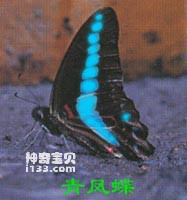Alias of the blue-banded swallowtail butterfly: the blue-banded swallowtail butterfly, the blue-banded swallowtail butterfly, the blue-banded swallowtail butterfly, and the green-banded swallowtail butterfly.
The adult wingspan is 70 to 85 mm. Wings black or light black. There is a row of green-blue square spots on the forewing, starting from the inside of the top corner obliquely in the middle of the rear edge, and the spots increase gradually from the front edge to the rear edge. The spot near the front edge is the smallest, and the spot at the rear edge becomes narrower. There are three spots from the middle of the front edge of the hind wing to the middle of the rear edge, of which one spot near the front edge is white or light blue-white; there is a row of crescent-shaped blue-blue markings on the outer edge; the outer edge is wavy and has no tail process. The male butterfly's hind wings have inner folds, which are densely covered with gray-white fragrant scales. The reverse side of the forewing is similar to the front side except that it is lighter in color. There is a short red line at the base of the reverse side of the hind wing, and several red markings on the middle and rear areas. Others are similar to the front. There are spring and summer types. The spring type is slightly smaller and the bluish spots on the wings are slightly wider.

Oval shape, shallow concave bottom. Milky yellow, smooth surface, strong luster. The diameter and height are both about 1.3mm.
The head and body of the first instar larvae are dark brown, but the ends are white. Later, the color gradually fades as the larvae grows, and by the fourth instar, the overall background color has turned green. Each section of the thorax has a pair of conical processes, which are light brown at the first age; blue-black with metallic luster at the second age; at the end of the age, the protrusions of the mesothoracic become smaller and the protrusions of the posterior thorax become sarcomas, with light brown appearing in the center. Streaks, a yellow horizontal line appears on the body connected to it; the valve is light brown; the stink horn is light yellow. The body color is light green and translucent when it is about to pupate.
The body color of the pupa varies depending on the location where it is attached, and has two types: green and brown. There is a forward-extending xiphoid process in the center of the thorax in the pupa; there is a longitudinal ridge on the back, which extends backward from the xiphoid process on the top of the head and is divided into 3 branches, two of which arc toward the side of the body and reach the tail end, and the other one extends toward the center of the back. When it reaches the front edge of the hindthorax, it divides into two parts and moves toward the tail end in an arc. The ridges of green pupae are yellow, making the pupa resemble the leaves of a camphor tree. Body length is about 33 mm.
Host: Litsea glutinosa, L.kostermansii, Cinnamomum comphora, C.micranthum, C.osmophloeum of Lauraceae ), C.japonica, Machilus thunbergii, M.zuihoensis, M.japonica, Lindera glauca, Annonaceae and other plants.
Biology: Multiple generations per year with overlapping generations, overwintering as pupae. Adults appear from March to October. They can be seen all year round in the tropics. They have strong flying ability and often move in humid and open areas at low altitudes. They are also common in gardens, streets and forest clearings. Sometimes they often gather in groups to rest in wet areas and pools in the morning and evening. It likes to visit flowers to suck nectar. It is commonly found on flowers of Lantana, Buddleia, Aesculus and other plants to suck nectar. Adult beetles often lay eggs singly at the ends of new shoots of host plants. Mature larvae pupate on the branches of host plants or in the shade of nearby debris.
Distribution: Shaanxi, Sichuan, Tibet, Yunnan, Guizhou, Hubei, Hunan, Jiangxi, Zhejiang, Hainan, Guangdong, Guangxi, Fujian, Taiwan, Hong Kong; Japan, Nepal, Bhutan, India, Myanmar, Thailand, Malaysia, Indonesia, Sri Lanka , Philippines, Australia.
animal tags:
We created this article in conjunction with AI technology, then made sure it was fact-checked and edited by a Animals Top editor.